If you love books – whether as a reader or a writer – and if you can spare 20 minutes, have a listen to this TED talk by children’s author Mac Barnett. His premise? A good book is a secret door into another world. Be prepared to smile . . .
Category: creativity
Yes, You Need That Break
 For writers who don’t write quickly, it can be hard to justify taking a break. Instead, we often push ourselves to write more, while mentally beating ourselves up for not being as prolific as we’d like. However, the research is clear: taking a break from what we’re working on can actually improve productivity. A new and growing body of research outlined in the New York Times shows that strategic renewal – daytime workouts, coffee breaks, time away from the office and longer, more frequent vacations – boosts productivity, job performance and health.
For writers who don’t write quickly, it can be hard to justify taking a break. Instead, we often push ourselves to write more, while mentally beating ourselves up for not being as prolific as we’d like. However, the research is clear: taking a break from what we’re working on can actually improve productivity. A new and growing body of research outlined in the New York Times shows that strategic renewal – daytime workouts, coffee breaks, time away from the office and longer, more frequent vacations – boosts productivity, job performance and health.
Many writers rely on the routine of a daily walk. Stephen King gets in about four miles a day; Charles Dickens logged about three hours every afternoon. Walking leads to more creative thinking than sitting does. Researchers from Stanford University found it boosted creative output by 60 percent. That’s significant. We walk Team Sheltie once or twice a day and I look forward to the break. It often sparks story ideas or helps with my work in progress.
But a walk is just a walk. And unless you cycle or drive to a new destination every day, the same old walking routine can become stale fast.
That’s where the artist’s date comes in. I’m sure you’ve heard of it. The brainchild of Julia Cameron, the artist’s date is a weekly solo expedition to explore something that interests you. It need not be overly ‘artistic.’ Cameron says it’s more ‘mischief than mastery.’ It’s meant to fire up the imagination and spark whimsy.
To be worthwhile, an artist date must happen every week and it must be taken alone. No friends, spouses, children allowed. It should involve leaving the house. What about being housebound because of bad weather, you ask. Cameron believes that an occasional in-house date if you’re alone and devoting yourself to something that ‘fills the well’ is acceptable but the goal is an excursion out of the house. Essentially, it’s a two-hour play date where you indulge your inner child.
It doesn’t have to cost anything, other than time. Some ideas:
Visit a shop that has nothing to do with what you actually do – an art supply store, a music store, a fabric, bead or (my favorite) a yarn shop.
Visit a U-pick farm.
Go to a graveyard and read the tombstones (it sounds morbid but this is great for writers who want story ideas).
Explore a neighboring town, or a part of your town you aren’t familiar with.
Take a hike.
Walk around town and take pictures of what inspires you.
Watch the birds.
Go to Home Depot with $5 in your pocket. See what cool things you can find to create an art project with five bucks. Go crazy.
Visit a plant nursery and plan your perfect garden.
Go to the library and find a book on a subject you know nothing about. Check it out.
Spend some time at a furniture auction.
Go for a bike ride.
Listen to live music.
Take yourself out for afternoon tea and people watch.
Visit a rock hound shop.
See a movie that appeals to you.
Go to a museum.
Watch a sunset.
Visit a farmer’s market.
And my personal favorite: walk on the beach and watch the waves crashing on shore.
Slow and Steady
 I received a lot of feedback on last week’s blog post about writing slowly. Most people who reached out seemed rather regretful that they don’t write faster. While it’s true that writing quickly can sharpen our skills and lead to more published books, the most important thing is consistent productivity, whether you write slowly or quickly.
I received a lot of feedback on last week’s blog post about writing slowly. Most people who reached out seemed rather regretful that they don’t write faster. While it’s true that writing quickly can sharpen our skills and lead to more published books, the most important thing is consistent productivity, whether you write slowly or quickly.
Here are some tips for staying productive even in the slow lane:
Choose your writing project carefully. Committing to a story you’re excited about will give you forward momentum and provide motivation.
Consider your personal time factor. Look objectively at how you currently use your time. Acknowledge the very real demands you face (outside work, children, aging parents) but also be realistic about where and how you waste time.
Set realistic writing goals. Base your goal on what you know will work, given your lifestyle and time constraints. Don’t overreach. Figure out what you can comfortably write in a week and schedule it in. Whether you set a weekly word or page count, or whether you commit to writing at a certain time, commitment is the key word in that sentence. And that leads to the next tip:
Be accountable. Share your goal with a partner, another writer, an online or in person writing group. It’s even better if they have a similar goal; you can motivate and encourage each other.
Keep your story top of mind. Have a copy of your work in progress readily available on your laptop, tablet, or in print form. Open the file so you see it first thing in the morning. Pull it out on your lunch break at work. Reading what you’re written, even if you get pulled away and can’t meet that day’s (or that week’s) goal, will pull you back into the story more quickly when you do return to it.
Minimize distractions as much as you can. Shut the door to your room or find a quiet space. Turn off social media. Wear noise cancelling headphones (it worked for me when I lived next door to a band!)
Bite off small chunks. Write for fifteen or thirty minutes. Set a timer and don’t stop writing until it goes off. Chances are, when it does, you won’t want to stop.
And speaking of stopping, one of the keys to consistent productivity is taking regular writing breaks. Yes, you read that right. Scheduled breaks help with productivity. More on that next week.
And That’s A Wrap
 The final few pages of a novel should bring a sense of completion and ideally some satisfaction or fulfillment too (which is why I love a well-written happily ever after). At the same time, a good ending should be logical, appropriate and have a sense of inevitability about it. It’s an art, hitting those perfect notes when writing a book. But it’s an art that allows for revising and tweaking until you’re satisfied with the story you’ve written.
The final few pages of a novel should bring a sense of completion and ideally some satisfaction or fulfillment too (which is why I love a well-written happily ever after). At the same time, a good ending should be logical, appropriate and have a sense of inevitability about it. It’s an art, hitting those perfect notes when writing a book. But it’s an art that allows for revising and tweaking until you’re satisfied with the story you’ve written.
Life isn’t like that. Endings come whether we’re ready for them or not. We can’t always control the outcome and they’re rarely as tidy as we’d like them to be. Endings have been on my mind a lot lately. Spring has ended and summer has started. This year, the end of spring brought a couple of things to competition in my life. And they were the best kind – happy endings.
The e fraud and stalled royalty issue I wrote about in a previous blog post https://lauralangston.com/the-royalties-that-failed-to-arrive/ has been resolved. There was a big, black moment near the end (as all good endings have) where the bank refused to compensate us for the fraudulent interception, but ultimately that decision was reversed. The money was returned and my royalty payment arrived soon after.
My first ongoing mosaic project reached a natural conclusion recently too (if you missed my process, go here: https://lauralangston.com/filling-the-well-mosaic-style/ ) I spent a few hours over a period of several weeks learning all about mosaic art and filling my creative well by trying something different. The final product may not be technically perfect or as artistically ‘tidy’ as I’d like it to be, but I’m happy with it.  In fact, I’m planning another mosaic project. And that’s another thing about endings. Done well, a good ending always brings with it the possibility of a new beginning, a fresh start.
In fact, I’m planning another mosaic project. And that’s another thing about endings. Done well, a good ending always brings with it the possibility of a new beginning, a fresh start.
Filling the Well, Mosaic Style
I’m not great at finding time to play, and that’s been especially true lately with so many demands on my time. But as Julia Cameron talks about in “The Artist’s Way” it’s critical to take breaks, interact with the world and fill the inner well that fuels our creativity.
I thought about that last week when I took a class from Debra Hagen, a Nanoose Bay artist who specializes in mosaic art. I knew almost nothing about mosaics until I visited Debra at her house (okay, technically Team Sheltie went on a play date to visit Debra’s two shelties, Seamas and Merlin, and the humans accompanied them). Her home is vibrant, welcoming and filled with samples of her gorgeous mosaic art. 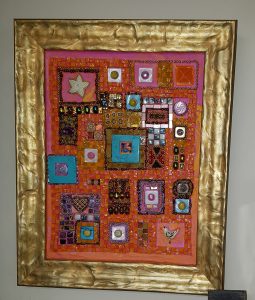
Every piece drew me in. Some were bold, others were more subtle, but they were all beautiful. When Debra said she gave classes in her studio downstairs, I was tempted, though I’m not at all artistic. I can’t draw, paint, or sculpt I told her. I’m lousy with textiles. I’d probably mess up papier-mache.
Debra assured me it didn’t matter, so I decided to make a trivet. Something bright for my new kitchen.
Debra’s studio overlooks the garden and it has the kind of happy vibe found in any creative space: a feeling of expectancy and a sense of promise. Plus, it’s filled with more of Debra’s stunning art.
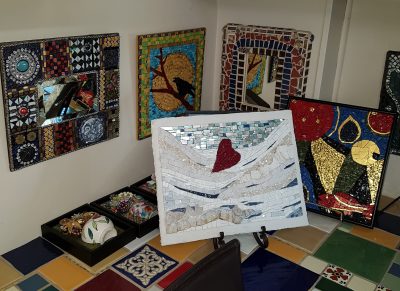
I enjoyed a cup of tea while Debra gave me a very brief introduction to mosaics. She pointed out her many containers of tesserae, the small blocks of stone, tile, glass or other materials used to make mosaics . . . and the pottery and china that can be broken up and also used in a mosaic. It’s referred to as pique assiette.
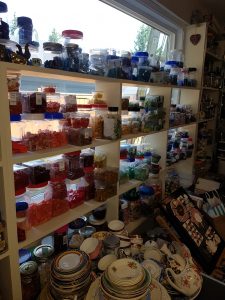
She talked about the substrate or rigid surface that you need to form the base, the adhesive or glue that’s used to attach the tesserae, and the basic tools like the wheeled nippers I’d need to do the job.
Like writing, the first step was settling on an idea and getting started. I quickly realized saying I was going to make a trivet was like saying I was going to write a novel. The statement was too broad. In the same way that a novel needs a plot or a character or a problem from which to build, my trivet needed something from which to build too: a central focus or a color or a piece of tile. Something. I decided on a heart for the center which Debra helped me outline on my plywood substrate.

We looked at the various bits of red tesserae that might work, but I wasn’t hooked. My eye kept going back to the china and pottery.
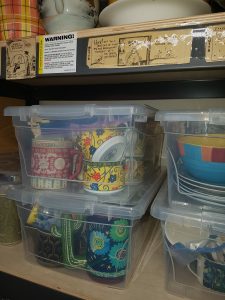
I found a plate with colors and a pattern I quite liked. Though it wasn’t at all red or heart-themed, something told me to go with it. I began breaking it up.

I hadn’t consciously noticed the couple on the plate when I chose it, but as I began to play with my layout, I decided they would form the center of the heart. How could they not?

Because I wanted to be sure I was happy with my layout, I placed many of the pieces on my substrate before I began gluing. That made for a longer process but I felt more confident doing it that way. At the end of the day, I wasn’t finished, but my heart had taken shape and I was thinking about background colors which I’ll tackle next time. 
Once the background tesserae is glued down, those small pieces will need 48 hours to dry before it’s time for the final step: grouting.
I left Debra’s studio feeling refreshed and energized . . . and thinking about my next mosaic project!
Debra is a great teacher. She’s instructive and helpful, and at the same time she’s wise enough to step back and let the artistic process unfold. For more information on her classes or to buy one of her mosaics, she can be reached at go************@***il.com
You Know You’re a Writer When . . .
 Here’s a blast from the past. . . a blog post I wrote in 2013 that’s as true today as it was back then.
Here’s a blast from the past. . . a blog post I wrote in 2013 that’s as true today as it was back then.
I wasn’t that odd as a child, not really, although if you ask my father he’d probably disagree. I was sensitive to my surroundings (especially to the undercurrents of conversations and what wasn’t being said); I was prone to storytelling (others referred to this as exaggeration); and I had three special (imaginary-to-everyone-else) friends. I played with them, had conversations (and arguments) with them and I ate meals with them too. This did not please my rational father. He didn’t realize he had a writer-in-the-making in the house.
How do you know you’re a writer? You know you’re a writer when –
You had imaginary friends as a child only they were real to you.
You are prone to wild imaginings that can literally make your heart race.
Conflict makes you smile.
You don’t get non-readers.
You laugh out loud at conversations in your head.
Some of the letters on your keyboard are worn off.
You have pens in every room of your house, including the bathroom and beside your bed.
A song on the radio sparks a story idea.
You stare at random people and memorize their quirks.
You can predict the conflict or turning points in movies, and your family has made you promise to keep quiet until it’s over.
You get excited by Scrivener.
Eavesdropping is second nature.
You love bookstores (but hate them if they don’t carry your books).
You live in a constant state of ‘what now?’ closely followed by ‘what if?’
Twist is not a cinnamon stick.
You have scribbled an idea, a word, or a piece of dialogue on a restaurant napkin, boarding pass, old envelope, school newsletter, or empty toilet roll.
You find those odd bits of paper – sometimes indecipherable – in pockets, wallets, purses, drawers, stuffed between the pages of a book, and you save them.
Pacing is a concept not an activity.
You found it easier to write when you first started.
You have missed a turn, an exit ramp or possibly a plane because you were so absorbed in your story.
You weren’t comfortable as a journalist because you always wanted to change the end of the story.
Proofreading is automatic.
Character is not about your personal ethics.
A hero must be flawed. But sexy as hell.
You gather ideas, thoughts, bits of trivia and snatches of dialogue like black pants gather lint.
You visit a cemetery and take notes.
People you barely know ask you to read their book, their article, their life story. Or ask you to write it.
You have a weird combination of insecurity and confidence.
Finishing the scene is more important than answering the phone.
The Muse is an intimate.
And, finally, you will read anything.
Just Listen
 A few weeks ago, I attended a weekend workshop. It had nothing to do with writing; it was about soul growth and reincarnation for those of us ‘woo’ types who believe in that sort of thing. In spite of the focus, writing was never far from my mind. That’s partly because I’m writing a book with a past life theme, but also because of a comment made by the facilitator.
A few weeks ago, I attended a weekend workshop. It had nothing to do with writing; it was about soul growth and reincarnation for those of us ‘woo’ types who believe in that sort of thing. In spite of the focus, writing was never far from my mind. That’s partly because I’m writing a book with a past life theme, but also because of a comment made by the facilitator.
“Imagination is real,” he said. “It’s a form of communication if only we’ll listen.”
We tend to think of imagination as pretend. His point was the opposite: imagination might be intangible and immeasurable, but it is as real as love, which also happens to be intangible and immeasurable. Imagination, he added, is communication from the soul . . . from spirit . . . from God . . . from the Source . . . whatever and however you describe it. I wondered if he was describing the muse?
Not every writer believes in a muse though many do, and Ray Bradbury was one of them. “I’m not in control of my muse,” he once said. “My muse does all the work.”
Steven Pressfield who wrote The War of Art believes in the muse too. “When we sit down each day and do our work, power concentrates around us,” he wrote. “The Muse takes note of our dedication. She approves. We have earned favor in her sight. When we sit and work, we become like a magnetized rod that attracts iron filings. Ideas come. Insights accrete.”
On the other side of the equation, a number of successful and prolific writers find the notion of a muse or any sort of communication absolutely ridiculous. Jodi Picoult, a favorite writer of mine, is one of them. Picoult believes writing is total grunt work; it’s not about the muse. Nora Roberts says every time she hears writers talk about the muse, she ‘wants to bitch-slap them.’ Stephen King says writing is a job like laying pipe or driving long-haul trucks. “It isn’t the Ouija board or the spirit-world we’re talking about,” King says.
Maybe not. But there’s no denying that for writers and other creative types our imagination bears a great deal of responsibility for the work we do.
The night before I sat down to write this blog, I saw Paul Simon interviewed on Stephen Colbert. He was talking about the inspiration for his song ‘Rene and Georgette Magritte With Their Dog After the War.’ Apparently, he was at Joan Baez’s house doing some collaborative work when Joan had to take a phone call. Restless or bored (or maybe a bit of both), he pulled a book off her shelf and began skimming it. He came across a picture of a man and a woman with a dog. Below the photograph was the caption ‘Rene and Georgette Magritte with their dog after the war.’
He began to think . . . to daydream . . . to weave a story out of the image. Communication, by definition, is a form of sending or receiving information. In that moment, Paul Simon was receiving something intangible that fed his imagination . . . and he listened.
In the end, I guess it doesn’t really matter whether you think imagination is real or pretend. All that really matters is listening to it. Listening and doing the work.
The Importance of Joy
 For those of us who are news junkies, last week was tough (one could argue that news junkies have had it tough for the last two years, but that’s a whole ‘nother blog). I spent way too much time focused on the Ford/ Kavanaugh testimony before the U.S. Senate, and listening to the analysis afterwards. It brought up a host of emotions for me, not the least of which was how difficult, painful and costly it can be to speak your truth, even when others attempt to deny it.
For those of us who are news junkies, last week was tough (one could argue that news junkies have had it tough for the last two years, but that’s a whole ‘nother blog). I spent way too much time focused on the Ford/ Kavanaugh testimony before the U.S. Senate, and listening to the analysis afterwards. It brought up a host of emotions for me, not the least of which was how difficult, painful and costly it can be to speak your truth, even when others attempt to deny it.
After a while I had to switch off, switch gears, and seek out something lighter. It was a good reminder of how valuable joyful fiction can be during difficult times.
That started me thinking about joy as a whole: where we find it, how we nurture it and why it matters. That led me to this Ted Talk by Ingrid Fetell Lee. It’s a fast listen – less than fifteen minutes – and it will make you smile. https://www.ted.com/talks/ingrid_fetell_lee_where_joy_hides_and_how_to_find_it?referrer=playlist-how_to_notice_and_build_joy_into_your_life
Hats and Books, Oh My
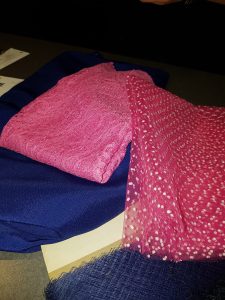 Writing books and making hats have something in common. Who knew? I certainly didn’t when I commissioned Lynda Marie http://www.lyndamariemillinery.com/to make a fascinator for me to wear to our daughter’s wedding. She knew the color of my dress (royal blue), the basic style (simple) and that I was wearing fun, in-your-face pink shoes. I wanted something elegant, I told her. Wedding guest classy, maybe with a little touch of sass.
Writing books and making hats have something in common. Who knew? I certainly didn’t when I commissioned Lynda Marie http://www.lyndamariemillinery.com/to make a fascinator for me to wear to our daughter’s wedding. She knew the color of my dress (royal blue), the basic style (simple) and that I was wearing fun, in-your-face pink shoes. I wanted something elegant, I told her. Wedding guest classy, maybe with a little touch of sass.
I was excited when she showed me some of the elements she planned to incorporate. It was going to be beautiful; I had no doubt about it.
A few weeks later she called to say it was ready. Full of anticipation, I went to her studio. The fascinator was gorgeous, I absolutely loved it, but it wasn’t what I expected. In fact, Lynda Marie ended up using almost none of the original elements she’d planned to use. “I tried,” she told me. “I really did. I kept fiddling and rearranging and trying to incorporate some of the pink polka dots and a little of the other material too, but the result just didn’t feel right.”
I know that feeling. There have been times, particularly in the early stages of a novel, where I’ll fiddle and rearrange and fiddle again. Something just doesn’t feel right. If I can’t stop fiddling, I know I need to take a step back and re-evaluate. Is the premise weak? The character’s motive flawed? Is the tone off? Am I worrying too much about whether the story will sell rather than the story I have to tell? If my gut tells me something is off, then something usually is off. Gut feelings rarely steer you wrong.
The same can be said for bespoke hats. “I was trying so hard to make it work but that first creation didn’t feel elegant,” Lynda Marie says. “I was fighting with the pink polka dots and trying to force it because we’d talked about using them, but the result was nothing remotely close to what we’d envisioned.” She pauses. “Some hats come together easily and others don’t, but as my boyfriend reminded me, if I didn’t like the result then chances are you wouldn’t either.” As soon as Lynda Marie let go of what she thought she needed to do and went with what the fascinator was trying to tell her, the piece came together quickly and easily.
Sometimes we have to get out of our own way, leave our expectations at the door, and let the hat or the book or the painting or the quilt (or whatever else we’re trying to create) tell us what it wants to be. Sometimes we have to let the muse have her way.
The results, inevitably, will always be far more beautiful than we could have imagined.
Hat (soon to be) In Hand
In six short weeks, Ms. Uptown Girl will be married. She’ll need a name change for my blog at that point since she’ll no longer be a Ms. or living uptown, but I digress.
In order for the wedding to proceed with any kind of class, I need a fascinator. Ms. Uptown is marrying into a British family (not that British family obviously) and the wearing of hats and fascinators for weddings, even a relatively simple 70 guest affair taking place outside beside the ocean, is something one does. The groom’s mother is wearing one, a number of her friends are wearing them too, and while I haven’t been told I must, it does seem a little, well, lacking in enthusiasm (if not taste) for the bride’s mother to turn up hatless.
And so I began to shop. Selection was thin to non-existent; I even struck out in the big city across the pond. There was nothing remotely suitable. I was either looking at hats big enough to power a small helicopter or pieces of lacy frippery designed more for a baby’s head than mine. Ordering on line was out of the question. I wanted to try it on for size and comfort, and it needed to work with whatever I ended up wearing. I was about to be hatless in Victoria.
Enter Lynda Marie: http://www.lyndamariemillinery.com/
The idea of having a fascinator made hadn’t occurred to me until I ordered my dress. When I mentioned then that I was looking for a fascinator and having some trouble finding one I liked, they pointed me in Lynda Marie’s direction.
She works out of her studio in Victoria where many of her creations are on display.

 I quickly fell in love . . . with her style and with her enthusiasm. Shopping had never been so much fun.
I quickly fell in love . . . with her style and with her enthusiasm. Shopping had never been so much fun.
She told me about her training in England where she studied under a milliner to the Queen Mother . . . and then how she’d trained in New York where she honed an edgier, more contemporary style. I learned that hats are made from hat block forms or moulds . . . that fascinators are light, decorative headpieces usually made with feathers or flowers or beads . . . and that those larger fascinators we saw on display at Harry and Meghan’s wedding are referred to in the trade as hatinators.

I learned that the sky is the proverbial limit in terms of color and style and all the fun, frippery bits that go along with it. As I write this, Lynda Marie is working her magic and creating something just for me. I can’t wait to see what she comes up with.

Check back because when she’s done and after the wedding, I’ll post a picture. I’m sure whatever she creates will be gorgeous! 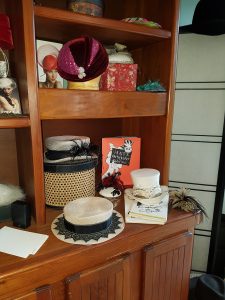

Comments